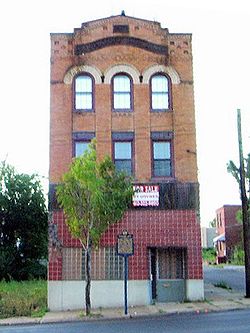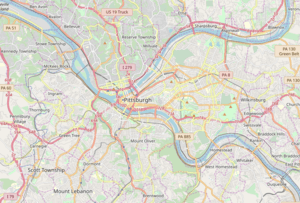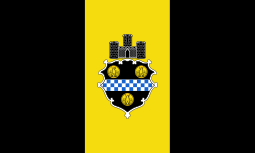Crawford Grill
The Crawford Grill was a renowned jazz club that operated in two locations in the Hill District of Pittsburgh, Pennsylvania. During its heyday in the 1950s and 60s, the second Crawford Grill venue hosted local and nationally-recognized acts, including jazz legends Art Blakey, Charles Mingus, Max Roach, Miles Davis, John Coltrane, Bill Evans, and Kenny Burrell. The club, an important social gathering spot for Pittsburgh's African-American communities, drew devoted listeners from the region's ethnically and racially diverse population making it a rare site of interracial socializing during the civil rights period. The Crawford Grill was one of many black-owned neighborhood clubs in the Eastern United States that supported a tour circuit for small jazz ensembles during the genre's "golden age." Despite the riots of 1968, which severely damaged the neighborhood's economic infrastructure, the club continued to operate until 2003, when it was shuttered. In 2010, a group of local investors purchased the property with the goal of restoring and reopening the location as a venue and restaurant.
Crawford Grill No. 2 | |
 Crawford Grill No. 2 (2009) | |
 Location of the Crawford Grill in Pittsburgh | |
| Location | 2141 Wylie Avenue Pittsburgh, Pennsylvania U.S. |
|---|---|
| Coordinates | 40.44567°N 79.97804°W |
| NRHP reference No. | 100005373 |
| Significant dates | |
| Added to NRHP | July 23, 2020 |
| Designated PHM | April 7, 2001 |
History
Origins of the Crawford Grill
The Crawford Grill can be best understood as the outgrowth of a broader set of social institutions that flourished in the Hill District neighborhood in the early 1900s. Known as "black-and-tan clubs", these venues featured black artists and catered to mixed-race patrons.[1] The Leader House (1401 Wylie Ave.) and the Collins Inn (1213 Wylie Ave.) were two "black-and-tan clubs" that operated in the 1910s that were important because they offered a means through which entrepreneur William "Gus" Greenlee would enter the entertainment industry in the Hill District and would later become the Crawford Grill and Black Musicians' Union Club. The high standard of entertainment was established by pianist Earl Hines, who began his career as a jazz musician in the Hill District when he was hired by bandleader Lois Deppe to perform at the Leader House, and violinist Vernie Robinson at the Collins Inn.[2] In 1922, the Collins Inn became the Paramount Inn under the ownership of Greenlee, who would become one of the Hill's most prominent African-American businessmen and owner of the Negro League baseball team the Pittsburgh Crawfords.[3] But the club had already had several owners by the time Greenlee acquired it in 1933.[4] It was purchased by Scott Bailey in 1932[5] and soon after was managed by James Brown, a local chef.[6] Brown remained when Greenlee acquired the business. Nevertheless, Greenlee may be soundly credited for making the club famous. Greenlee's remodeled held its grand opening on Christmas Eve of 1933.[7] A formal opening took place the following January.[8] It was the first in the neighborhood to receive a liquor license (prohibition had been repealed for less than a month). An enthusiastic announcement in the Pittsburgh Courier promised patrons a bar designed after a Spanish hacienda, with "cool, drinks and good food served in ultra, ultra style."[7] The Crawford Grill had several incarnations at different addresses during its lifetime.
Crawford Grill No. 1 (1933–1951)
The original club was located at 1401 Wylie Ave. at Townsend in a hotel called the Leader House,[9] which had been established in the 1910s. The third floor of the three-story structure was reserved for VIPs.[10] Known colloquially as "Club Crawford," it served as Greenlee's reception room and office.[10] The audience was racially and socially mixed. Locals from the Hill District were patrons, as were Pittsburgh's powerful families, athletes, and celebrities from out of town.[11] According to Ralph Proctor, a professor of African American History, "The Grill provided a place of elegance in an area outsiders tended to think of as down-trodden." Nelson Harrison, a trombonist who played at the Crawford Grill, said, "The Grill was a melting pot. It had a peaceful, loving atmosphere. There was never any trouble."[10] It remained in business until 1951 when it was destroyed by a fire. The building was demolished in 1959 as part of the Civic Arena development plan.[12]
The second floor featured the C&G Club with a revolving stage, upright piano clad in mirrors, and glass-topped bar. In addition to a program of out-of-town entertainers, Greenlee promised two special programs: "Chill Night" featuring Greenlee himself in the kitchen, and "Jewish Night", when his wife, Helen, did the same.[13] The second-floor club opened in March 1935 with entertainment produced by Billy Maxey, featuring New York and Ohio performers. Local press declared it the Hill's "most popular 'hot spot'".[4]
Crawford Grill No. 2 (1943–2003)
With his business partner Joseph Robinson, Greenlee opened a second venue on the corner of Wylie Avenue and Elmore Street, approximately ten blocks east of the original location. Robinson's son, William "Buzzy" Robinson, ran the club for almost 60 years,[10] selling the business but retaining ownership of the building in 1992.[14] In 2001, the Pennsylvania Historical and Museum Commission dedicated a marker on the site.[15] Facing electrical and sewage problems, the last surviving Crawford Grill location (No. 2) closed its doors in 2003 and was put up for sale in 2006.[16]
Crawford Grill No. 3 (1948–1955)
Located on the corner of Bidwell Street and Pennsylvania Avenue in the Manchester neighborhood of Pittsburgh, this club closed in just seven years.[12]
New Crawford Grill at Station Square (2003–2006)
Capitalizing on the famous Crawford Grill name, Les Montgomery and Tom Burley opened a new venue at 125 W. Station Square Drive in the Freight House Shops, in Pittsburgh's South Side neighborhood.[17] The interior, designed by local architect Margaret Ringel,[18] included seating for 180 guests, a bar, and a balcony. Hewing closely to the original Grill, the menu featured soul food.[19] The venture was financed partly by the Urban Redevelopment Authority and promised 20-30 new jobs.[18] Initially the new club was successful; upon the first anniversary of its opening, a newspaper described it as a "regular destination for jazz lovers."[17] One local patron praised the new Grill, finding the music as good as it was in the original club during its heyday.[20] Despite being awarded "best soul food" by a local paper three years running, the new club suffered from lack of foot traffic, closing its doors on January 7, 2006.[21]
Legacy and the Crawford Grill Revitalization Project
After the closure of the Crawford Grill No. 2, building owner Buzzy Robinson sought buyers who would respect the legacy of the site.[22] In 2010, local sources announced that an investment group including Pittsburgh Central Keystone Innovation Zone, Pittsburgh Gateways Corporation, Hill House EDC, and several private individuals had purchased the building for $275,000.[23] Calling their initiative the "Crawford Grill Revitalization Project,"[23] the group has stated it aims to preserve the legacy of the building through restoration efforts and the establishment of a new restaurant and nightclub.[24][25]
Historical marker
The Pennsylvania Historical and Museum commission unveiled a blue and gold historical marker outside the Crawford Grill building on April 7, 2001. The unveiling marked the conclusion of a three-day conference focused on black history in Pennsylvania. In attendance were Pittsburgh councilman Sala Udin, the building's owner, William "Buzzie" Robinson, and the owner of the Crawford Grill business, Keith Ferris.[26]
In popular culture
- Referenced in the play Fences by August Wilson
References
- Snelson, Floyd (March 5, 1932). "Snelson Reviews 'Black and Tan' Craze in Metropolitan Centers". Pittsburgh Courier. p. A1.
- Dance, Stanley (1983). The World of Earl Hines. Da Capo Press. p. 29.
- Ingham, John N. (1994). African-American Business Leaders: A Biographical Dictionary. Greenwood Press. p. 298.
- "C&G Club Looms as Most Popular 'Hot Spot' on Hill". The Pittsburgh Courier. March 30, 1935. p. A9.
- "Scott Bailey Buys Out Crawford Grill". The Pittsburgh Courier. November 12, 1921. p. 4.
- "Famous Chef Now Manages Crawford Grill". The Pittsburgh Courier. October 28, 1933. p. 7.
- "The New Crawford Grill Opens with the Repeal Glory in "New Ways and Wines" on Xmas Eve". The Pittsburgh Courier. December 23, 1933.
- "Gus Greenlee's Crawford Grill to Open Formally next Tuesday". The Pittsburgh Courier. January 6, 1934. p. A6.
- Sebak, Rick (February 2007). "The Hill was alive with the sound of music". Pittsburgh Magazine: 160.
- Klein, Barbara (Winter 2015). "Taking its Bow". Carnegie.
- Knoch, Ashley (January 16, 2014). "Let's Learn From the Past: The Crawford Grill". Pittsburgh Post-Gazette. Retrieved January 4, 2016.
- "Owner of the Legendary Crawford Grill and the Pittsburgh Crawfords". Pittsburgh Music History. Retrieved 27 July 2013.
- "C&G Club Hill's Newest Hot Spot". The Pittsburgh Courier. March 2, 1935.
- Pfister, Bonnie (June 16, 2007). "Jazz History for Sale in Hill District". Pittsburgh Tribune-Review. p. B1, B6. Archived from the original on March 10, 2016. Retrieved January 4, 2016.
- "Crawford Grill Historical Marker". Pennsylvania Historical and Museum Commission. 7 April 2001.
Text from historical marker: A center of Black social life where musicians such as Art Blakey, Mary Lou Williams, John Coltrane drew a racially mixed, international clientele. Here, Crawford Grill number 2, the second of three clubs opened 1943; was owned by William (Gus) Greenlee, later by Joseph Robinson.
- Guidry, Nate (15 November 2006). "Hill District landmark Crawford Grill for sale". Pittsburgh Post-Gazette.
- "Crawford Grill on the Square Celebrates First Anniversary". Pittsburgh Courier. June 27, 2004. p. A1.
- Morrow, Christian (May 1, 2002). "Rebirth of the Cool". Pittsburgh Courier. p. B1.
- Morrow, Christian (July 2, 2004). "The Oldest but Newest Jazz Venue". Pittsburgh Courier. p. A1-A2.
- Guidry, Nate (November 26, 2002). "Crawford Grill sizzles with Jazz by Jones-Fuller". Pittsburgh Post-Gazette. p. E2.
- Morrow, Christian (January 11, 2006). "Crawford Grill closes its doors, blames poor foot traffic". Pittsburgh Courier. p. A1, A5.
- Guidry, Nate (November 15, 2006). "Hill District landmark Crawford Grill for sale". Pittsburgh Post-Gazette. Retrieved January 4, 2016.
- Spencer, Malia (March 1, 2010). "Group of nonprofits, investors aim to bring Crawford Grill back". Pittsburgh Business Times.
- Editorial Staff (April 14, 2010). "Crawford Grill purchased…Franco Harris part of investment group". New Pittsburgh Courier. Retrieved 13 August 2015.
- Little Red Media (2013). Jessica Lee on the Crawford Grill Renovation. Retrieved 2016-01-04.
- Brown, Charles N. (April 11, 2001). "Crawford Grill Honored with Historic Marker". New Pittsburgh Courier.
External links

